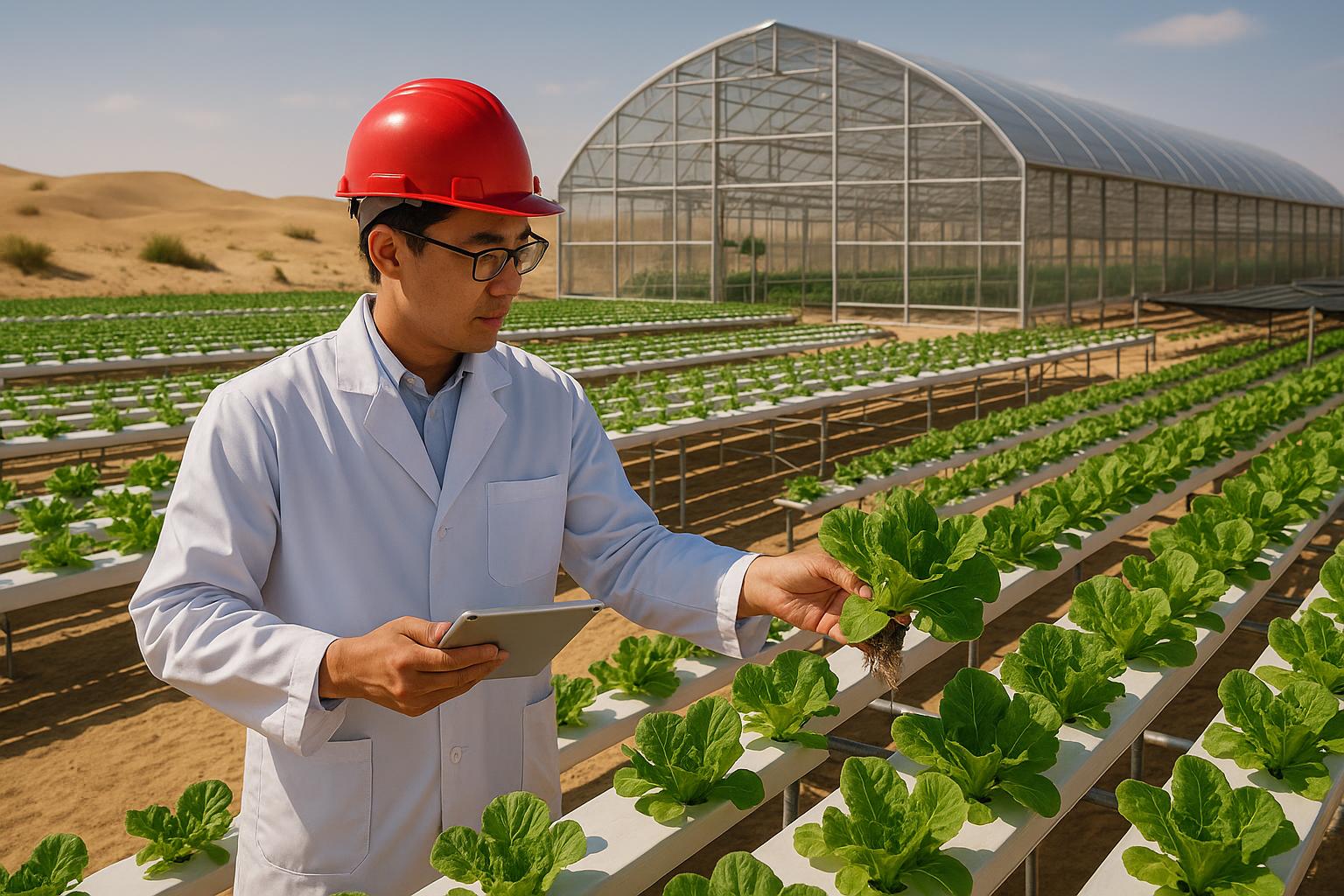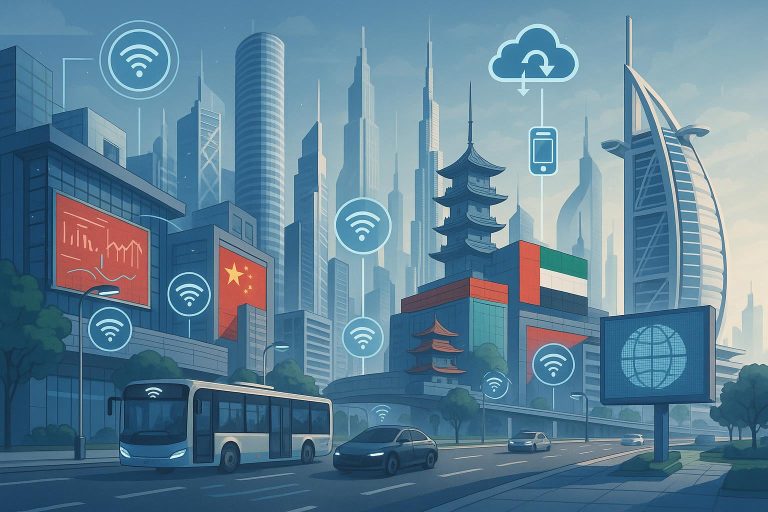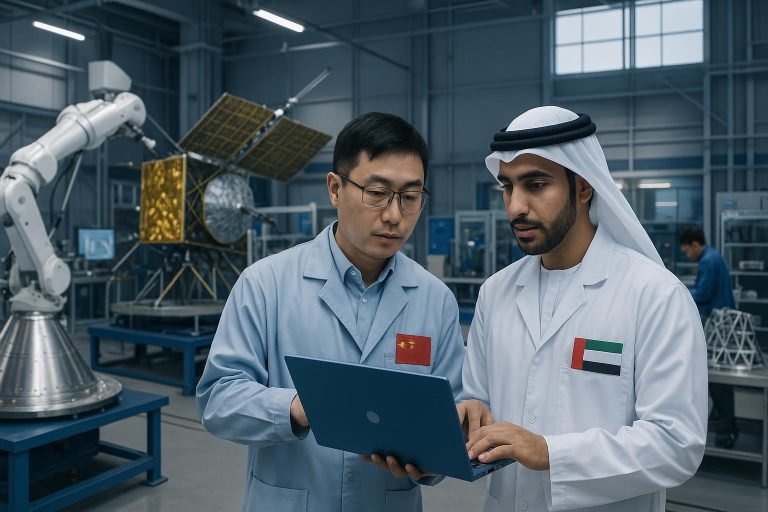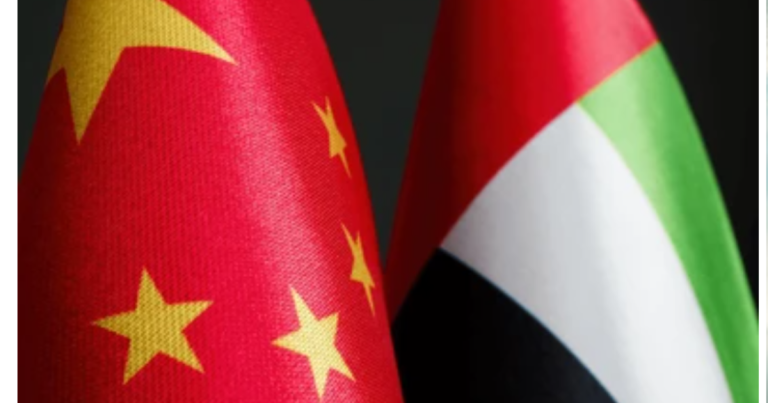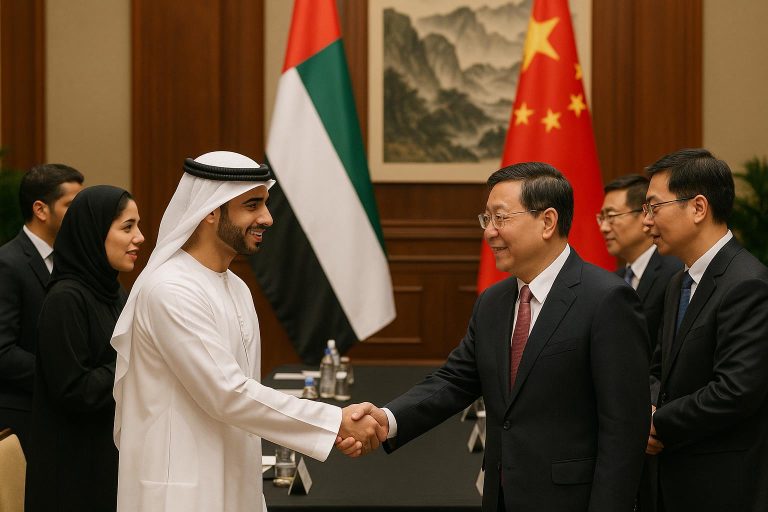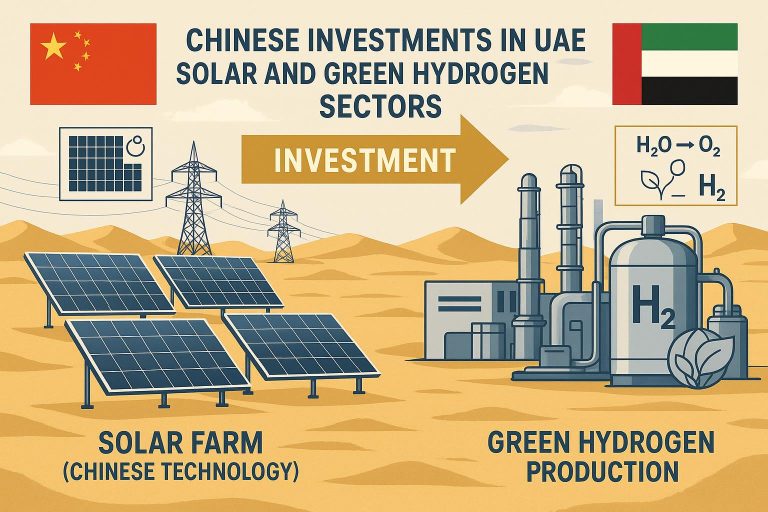Cultivating the Desert: The Role of Chinese Agri-Tech in Bolstering the UAE’s Food Security Strategy.
Executive Summary
The United Arab Emirates (UAE) and China are forging a robust partnership in agricultural technology (agri-tech) to significantly enhance the UAE’s food security. This collaboration is a critical facet of their broader comprehensive strategic partnership, which has seen bilateral trade reach a record $101.8 billion in 2024 [1]. With the UAE’s arid climate posing inherent challenges to conventional agriculture, Chinese agri-tech solutions, particularly in areas like hydroponics, organic farming, and smart agricultural projects, offer transformative potential. Landmark initiatives, such as the $33 million smart agricultural project between Silal and China’s Shouguang Vegetable Group (SVG), and SVG’s additional investment of over AED 120 million in a 100,000m² agri-tech facility in Al Ain, underscore the depth of this cooperation. This article explores how Chinese innovation is not only addressing the UAE’s food production challenges but also creating new opportunities for sustainable growth, while critically examining the strategic drivers, inherent challenges, and future outlook of this vital bilateral endeavor. The synergy between China’s technological prowess and the UAE’s strategic vision is cultivating a new paradigm for food resilience in the desert.
Introduction
The United Arab Emirates, a nation characterized by its arid climate and limited arable land, has long recognized the imperative of achieving robust food security. This strategic priority is not merely about sustenance but is intrinsically linked to national resilience, economic diversification, and sustainable development. Simultaneously, China, a global leader in agricultural technology and innovation, has been actively expanding its international partnerships, particularly within the framework of the Belt and Road Initiative (BRI). The convergence of these two national agendas has fostered a dynamic and increasingly vital collaboration in the realm of agri-tech. This article delves into the burgeoning partnership between the UAE and China, specifically examining how Chinese agricultural technology is playing a pivotal role in bolstering the UAE’s ambitious food security strategy. We will explore the historical context of their comprehensive strategic partnership, analyze the current landscape of bilateral cooperation in agri-tech, identify key opportunities and strategic growth drivers, address the challenges and critical considerations, and present a compelling case study. Ultimately, this analysis aims to provide a comprehensive outlook on the future trajectory of this collaboration and offer strategic recommendations for its continued success, underscoring how the synergy between Chinese innovation and UAE vision is transforming the desert into a hub of agricultural advancement.
The Current Landscape of Bilateral Cooperation
The relationship between the United Arab Emirates and China has evolved into a comprehensive strategic partnership, characterized by deep economic ties, robust diplomatic engagement, and expanding collaboration across diverse sectors. This partnership, formally established in 2018, has fostered an environment conducive to significant bilateral investment and trade, which serves as the bedrock for specialized cooperation areas such as agri-tech. The economic indicators vividly illustrate the strength of this relationship: bilateral trade soared to a record $101.8 billion in 2024, marking an astounding 800-fold growth since 1984 [1, 2]. This makes the UAE China’s largest export market in the Middle East and its second-largest trading partner in the region, while China consistently remains the UAE’s largest trading partner.
Beyond trade, investment flows are equally impressive. By the end of 2023, UAE investments in China had reached $4.5 billion, representing a substantial 96% increase from the previous year [1, 2]. The presence of over 15,000 Chinese firms operating in the UAE further underscores the deep integration of their economies [1]. Institutional frameworks, such as the UAE-China Investment and Economic Cooperation Working Group, facilitate regular high-level diplomatic engagements and the signing of strategic agreements, ensuring a stable and predictable environment for collaboration.
While the partnership spans numerous critical sectors—including Energy & Clean Energy (e.g., Masdar-China Silk Road Fund MoU for renewable energy projects), Infrastructure & Logistics (e.g., COSCO terminal at Khalifa Port, China-UAE Industrial Capacity Zone), Technology & AI (e.g., digital transformation initiatives), Trade & Free Zones (e.g., JAFZA partnerships), and Finance & Investment (e.g., Belt and Road Initiative projects totaling $3.1 billion in the UAE)—the focus on Agriculture & Food Security has gained particular prominence. Recognizing the UAE’s inherent challenges in food production due to its arid climate, both nations have strategically prioritized agricultural cooperation. This includes agreements aimed at strengthening agricultural ties and significant investments in modern agricultural technologies [1, 5]. The geographic focus areas, with Abu Dhabi as a primary investment hub and Dubai playing a crucial role in trade facilitation, further enhance the logistical and operational efficiency of these joint ventures. This broad and deep cooperative landscape provides a fertile ground for Chinese agri-tech to flourish in the UAE, directly contributing to its food security ambitions.
Opportunities and Strategic Growth Drivers
The confluence of the UAE’s urgent need for food security and China’s advanced agri-tech capabilities presents a fertile ground for strategic growth and mutual benefit. The UAE’s National Food Security Strategy aims to achieve a top-ten ranking in the Global Food Security Index by 2051 [6], necessitating innovative solutions to overcome its inherent environmental limitations. Chinese agri-tech, with its expertise in controlled environment agriculture, water-efficient irrigation systems, and smart farming, offers precisely these solutions.
One of the primary growth drivers is the transfer of advanced agricultural technologies. China has made significant strides in developing sustainable farming practices adaptable to diverse and challenging environments. Technologies such as hydroponics, aeroponics, vertical farming, and precision agriculture, which utilize AI and IoT for optimized resource management, are highly relevant to the UAE’s context. These methods drastically reduce water consumption, maximize yield in limited spaces, and enable year-round production of fresh produce, directly addressing the UAE’s climatic constraints.
Investment and joint ventures form another crucial driver. The substantial increase in UAE investments in China and the presence of numerous Chinese firms in the UAE create a robust financial ecosystem for agri-tech collaborations. The Belt and Road Initiative (BRI) further facilitates these investments, with significant capital already allocated to projects in the UAE. This financial backing enables the establishment of large-scale, technologically advanced agricultural facilities that would otherwise be cost-prohibitive or technically challenging for the UAE to develop independently. The commitment of over AED 120 million by China’s Shouguang Vegetable Group (SVG) for a 100,000m² agri-tech facility in Al Ain exemplifies this trend, demonstrating a tangible commitment to developing local food production capabilities [1, 8].
Furthermore, the diversification of food sources and supply chains is a key strategic opportunity. By developing local production capabilities through Chinese agri-tech, the UAE can reduce its reliance on food imports, thereby enhancing its resilience against global supply chain disruptions and geopolitical volatilities. This localized production also supports the UAE’s economic diversification agenda, creating new industries, jobs, and fostering a knowledge-based economy centered on sustainable agriculture.
Knowledge exchange and capacity building are also vital. The collaboration extends beyond mere technology transfer to include the sharing of expertise, research, and development. This fosters a learning environment where Emirati professionals can acquire skills in advanced agricultural techniques, ensuring the long-term sustainability and local management of these projects. The strategic partnership framework, including regular high-level dialogues, ensures that these opportunities are continuously identified, nurtured, and implemented effectively, driving both nations towards shared goals of prosperity and food security.
Challenges and Critical Considerations
While the collaboration between the UAE and China in agri-tech presents significant opportunities, it is not without its challenges and critical considerations that require careful navigation. Addressing these issues proactively will be crucial for the long-term success and sustainability of these initiatives.
One significant challenge lies in the environmental adaptation of technology. While Chinese agri-tech solutions are advanced, their optimal performance in the UAE’s extreme desert climate, characterized by high temperatures, intense solar radiation, and limited water resources, requires continuous research and adaptation [7]. Technologies developed for temperate climates may need substantial modifications to be energy-efficient and cost-effective in the UAE. The high energy demands of controlled environment agriculture, such as hydroponics and vertical farms, can be a considerable operational expense, necessitating integration with renewable energy sources to ensure economic viability and environmental sustainability.
Economic viability and scalability pose another critical consideration. The initial capital investment for advanced agri-tech facilities can be substantial. Ensuring that these projects can achieve profitability and scale to meet a significant portion of the UAE’s food demand requires careful financial planning, market analysis, and policy support. The cost of locally produced food must remain competitive with imported alternatives to ensure consumer adoption and market penetration. Furthermore, the reliance on foreign technology and expertise, while beneficial in the short term, necessitates a clear strategy for localization and knowledge transfer to build indigenous capabilities and reduce long-term dependency.
Regulatory frameworks and standardization also present potential hurdles. Harmonizing agricultural standards, food safety regulations, and intellectual property rights between the two nations is essential for seamless technology transfer and market access. Differences in regulatory approaches could impede the efficient deployment and operation of joint ventures. Clear and consistent policies are vital to attract and retain investment in this nascent sector.
Finally, cultural and operational differences can impact project implementation. While both nations are committed to the partnership, variations in business practices, communication styles, and operational methodologies can lead to misunderstandings or inefficiencies. Effective cross-cultural management and robust partnership agreements are necessary to mitigate these risks and foster a collaborative working environment. Overcoming these challenges will require sustained commitment, adaptive strategies, and continuous dialogue between the UAE and China, ensuring that the promise of agri-tech collaboration is fully realized.
Case Study Spotlight
A prime example of the transformative potential of Chinese agri-tech in the UAE is the collaboration between Silal, Abu Dhabi’s new fresh produce and agri-tech company, and China’s Shouguang Vegetable Group (SVG). This partnership epitomizes the strategic alignment between the UAE’s food security ambitions and China’s technological prowess. The initial $33 million smart agricultural project between these entities laid the groundwork for advanced farming practices in the region [1, 5]. Building on this success, SVG has committed an additional investment of over AED 120 million (approximately $32.7 million USD) to establish a sprawling 100,000m² agri-tech facility in Al Ain [1, 8]. This facility is designed to incorporate cutting-edge technologies such as hydroponics and organic farming, focusing on high-yield, sustainable production of various crops. This initiative not only introduces advanced farming methods but also serves as a model for how international partnerships can directly contribute to local food production capabilities, demonstrating a tangible step towards reducing reliance on imports and fostering agricultural self-sufficiency in the desert environment.
Future Outlook and Strategic Recommendations
The future outlook for UAE-China cooperation in agri-tech is exceptionally promising, poised for continued growth and diversification. As both nations deepen their comprehensive strategic partnership, the focus on innovation and sustainable development will drive further collaboration. The UAE’s commitment to its National Food Security Strategy, coupled with China’s continuous advancements in agricultural science and technology, creates a powerful synergy. We can anticipate an expansion of existing projects and the emergence of new initiatives, particularly in areas such as AI-driven precision farming, biotechnology for crop enhancement, and advanced water management systems.
To maximize the potential of this partnership, several strategic recommendations can be put forth:
- Establish Joint R&D Hubs: Create dedicated research and development centers in the UAE, jointly funded and staffed by Emirati and Chinese experts. These hubs would focus on adapting Chinese agri-tech to local conditions, developing new desert-specific agricultural solutions, and fostering local talent. This would accelerate innovation and ensure long-term sustainability.
- Facilitate Technology Transfer and Localization: Implement clear policies and incentives to encourage the transfer of intellectual property and technical know-how. This includes training programs for Emirati farmers and technicians, ensuring they are equipped to operate and maintain advanced agri-tech systems independently.
- Streamline Investment and Regulatory Frameworks: Further simplify investment procedures and harmonize regulatory standards to attract more private sector investment from both countries into the agri-tech sector. This could involve creating special economic zones dedicated to agricultural innovation.
- Promote Sustainable Practices: Emphasize projects that integrate renewable energy sources, water recycling, and organic farming methods to ensure environmental sustainability alongside food production goals. This aligns with both nations’ broader commitments to climate action.
- Expand Market Access and Distribution: Develop robust supply chain infrastructure and market linkages to ensure that locally produced, high-quality agricultural products can efficiently reach consumers within the UAE and potentially beyond. This includes leveraging the UAE’s strategic logistical position as China’s Gulf gateway.
By proactively implementing these recommendations, the UAE and China can further solidify their agri-tech collaboration, transforming the desert into a vibrant agricultural landscape and setting a global benchmark for food security through international partnership.
Conclusion
The strategic partnership between the UAE and China has proven to be a powerful catalyst for advancing the UAE’s food security agenda, particularly through the pivotal role of Chinese agri-tech. This collaboration, rooted in a comprehensive strategic partnership and robust economic ties, has facilitated the transfer of innovative agricultural technologies, substantial investments, and invaluable knowledge exchange. While challenges related to environmental adaptation, economic viability, and regulatory harmonization exist, the proactive engagement of both nations, exemplified by projects like the Silal-Shouguang Vegetable Group partnership, demonstrates a clear commitment to overcoming these hurdles. By embracing Chinese expertise in hydroponics, organic farming, and smart agricultural solutions, the UAE is not merely cultivating crops in the desert; it is cultivating resilience, sustainability, and a diversified economic future. The continued strategic alignment and mutual commitment to innovation will undoubtedly ensure that this partnership remains a cornerstone of the UAE’s journey towards achieving comprehensive food security.
References
[1] Research findings provided by the UAE China Chamber of Commerce.
[2] Bilateral trade data and investment figures from official UAE and China government reports (as cited in provided research findings).
[3] Details on the comprehensive strategic partnership and working groups (as cited in provided research findings).
[4] Information on key cooperation sectors, including Energy & Clean Energy, Infrastructure & Logistics, Technology & AI, Trade & Free Zones, and Finance & Investment (as cited in provided research findings).
[5] Specifics on agricultural cooperation agreements and projects, including Silal and Shouguang Vegetable Group initiatives (as cited in provided research findings).
[6] UAE National Food Security Strategy objectives and goals (as cited in provided research findings).
[7] Information on challenges and considerations in agri-tech implementation in arid climates (as cited in provided research findings).
[8] Details on the Shouguang Vegetable Group (SVG) investment in Al Ain (as cited in provided research findings).

